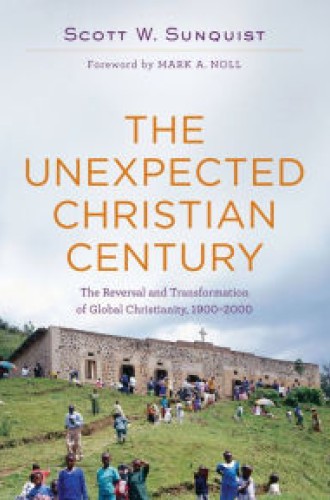What is the Christian century?
In the January 1900 issue of the Christian Century, then editor C. A. Young wrote optimistically about the potential for the growth of Christianity around the world: “May not the coming century be known as the Christian Century?” From his vantage point in North America, Young foresaw a steady advance of Christianity from the West to “the rest.”
The 20th century did indeed see dramatic growth in the geographical extent and character of Christianity. At the same time that people in Africa, Asia, Latin America, and elsewhere took hold of Jesus and the Bible in new ways, people in the Euro-Atlantic world began to turn away. In the global ecumenical movement, historic Christian denominations began working together in unprecedented fashion even as new independent and Pentecostal churches began appropriating the Christian message in ways that challenged traditional understandings of church. In the second half of the century, new waves of migration brought further change. By the end of the century, the body of Christ was more diverse, global, and interconnected than at any other time in history—but not at all in the way Young had envisioned.
Read our latest issue or browse back issues.
Scott Sunquist calls this the “unexpected Christian century.” Dean of the School of Intercultural Studies at Fuller Theological Seminary, Sunquist is well positioned to offer a survey of a transforming century. In thematic chapters, he examines the impact that politics, migration, and other religions have had on the development of Christianity both by tracing their effects on large confessional families of churches and by profiling two dozen individuals who have had a significant influence on global Christianity. The result is a book that ranges widely but does not always dig deep.
Several themes recur. Perhaps the most profound is also the simplest: the figure of Jesus Christ inspires, challenges, and transforms people across time, space, and culture. The book is replete with examples of people whose lives were changed by their encounter with Jesus. Prophet Simon Kimbangu, an itinerant Congolese preacher and political prisoner who died in 1951, became the inspiration for the Church of Jesus Christ on Earth, still a large church in central Africa. Bishop K. H. Ting sought to hold together Christianity and the Communist Party of China, not always successfully, but in a way that continues to shape Chinese Christianity.
Another recurring theme is the movement of Christians away from a Christendom model in which church and state power were closely linked, to one in which Christianity has more independence from temporal sources of authority. Sunquist sees a transition from a powerful church at the center of Western society to a weak church at the periphery of many non-Western societies. “With so little political voice,” Sunquist writes, “there would seem to be little to deter” violence against Christians. “The future does not look bright for Christians as we see less and less political and institutional power to protect” the church, he asserts.
This tells only part of the story. The death of European Christendom is clear. But part of the appeal of Christianity in many parts of the world is its association with political and economic power. When political officials attend church events in Uganda, or Korean pastors offer de facto endorsements of candidates, it is clear that church-state relations in other parts of the world are still evolving. We should pay special heed to truly marginalized and suffering Christian communities, and we should debate the proper form of church-state relations, but we can do so only with a clear picture of the diversity of global Christianity.
Although Sunquist discusses political change in the 20th century, he has far less to say about the concomitant economic transformation and the emergence of a globalized capitalist consensus. The links between the economic and religious changes of the century are fascinating. Liberation theology and the renewal it brought to Latin American churches, for instance, came against a backdrop of sharp economic inequalities. Acute economic turmoil in West Africa in the 1980s led to the growth of new forms of Pentecostal Christianity that seem well suited to helping their adherents make their way in a new economy. In a similar vein, the links between the economic transformation of China in the last two generations and the rapid growth of Christianity demand further study. Sunquist eschews such analysis and writes instead, “It is still a mystery why Christianity is so much at home today in China, or Ghana, or South Korea.” This is a helpful reminder that the growth of the church is always beyond our complete explanation. Still, given the considerable scholarship in this area, it is an oversight that weakens the book.
In a book about global Christianity, Sunquist pays surprisingly little attention to the African church. When African Christianity appears, it is often in reference to independent churches, such as the Kimbanguists. But the face of Christianity across much of Africa continues to be expressed in mission denominations, Protestant and Catholic. We hear little from Sunquist about the many creative appropriations of the Christian message that have taken place in these churches. He discusses the East Africa Revival, a significant Protestant movement dating to the 1930s, only in the context of a category he calls spiritual churches. Such churches do continue to transform Christianity, but Sunquist makes no mention of more recent African-originated denominations, such as the Redeemed Christian Church of God and the Zimbabwean Apostolic Assemblies of God. Increasingly these churches are becoming transnational entities, spreading around the world far more successfully than earlier spiritual denominations ever did and shaping both Western and non-Western churches.
The book is also weakened occasionally by unsubstantiated sweeping claims. For instance, in the chapter on migration—surely one of the most significant factors in shaping religious life in the world—Sunquist writes, “Migration often enhances religious vitality.” Such a claim leaves the reader asking why. What is it about migration, voluntary or otherwise, that makes people look at religion in a new light? Do biblical stories of migration offer any guidance? The claim is important but is left unexplored.
The unexpected Christian century has produced a global body of Christ that often seems to challenge and frustrate Christians as much as it enriches and guides us. To find our way forward, we need greater knowledge and understanding of our sisters and brothers in Christ around the world. Sunquist’s book highlights interesting aspects of the development and emergence of the global church. But it’s an incomplete telling of the story of God’s creative work in our midst.







